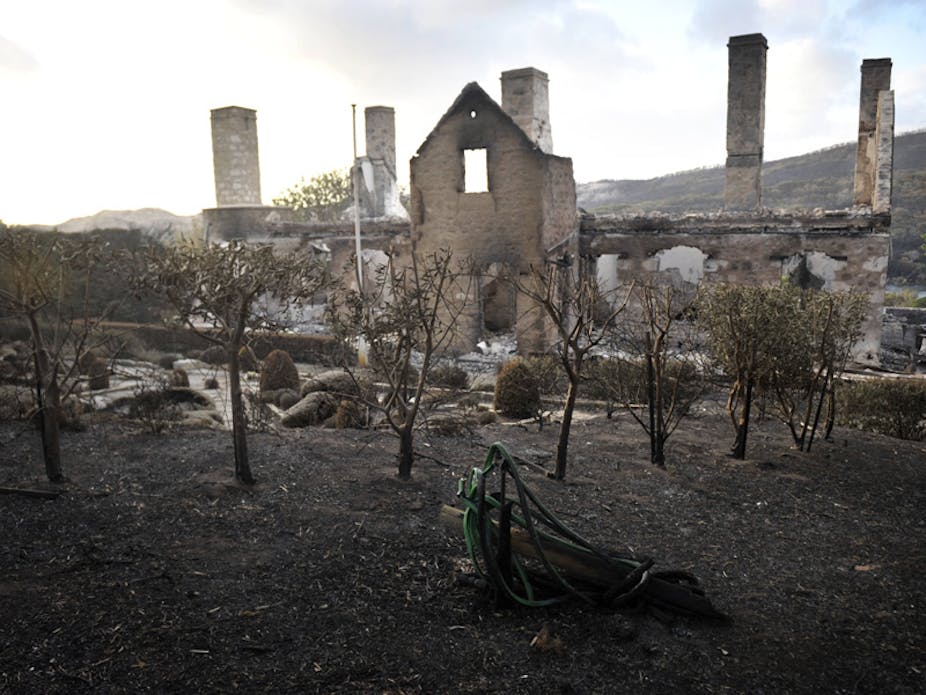Scientists are increasingly expected to engage with the media to communicate their findings. My research leads me to believe Hobart is at risk from a severe bushfire disaster – but what are my responsibilities in talking to the press about this?
To get a run in the media, there is strong pressure to add spice and tell an interesting story; but qualifications and complexity get in the way. This problem particularly affects climate change research – some argue that climate scientists should stick to the facts, highlight the uncertainties and avoid alarmist statements.
Climate change modelling can never provide detailed weather forecasts into the future. Modelling also can’t tell us how climate change will affect specific places. Ecology is extremely difficult to build into climate change models, so models also can’t grapple with how the biosphere will respond to climate change.
This makes it difficult for ecologists to “stick to the facts” when talking about climate change. In a nutshell, there are enormous uncertainties about how ecosystems will respond to climate change.
A good example is the occurrence of bushfires.
Severe bushfires happen only after a specific sequence of weather patterns. First, wet, warm conditions must create abundant plant growth. A dry spell must then convert the plant growth to combustible fuel. Finally, hot, dry, windy conditions are required to spread a fire once it’s ignited by either lightning or people.
I cannot – and nor can anyone else – predict with any confidence when the next bushfire disaster will occur. The only certainty is that there will be severe bushfire when all these factors align in the future. Such fires will occur regardless of climate change.

The uncertainty in ecological forecasts has substantial consequences for ecologists engaging with the media. Consider, for instance, my conviction that Hobart, where I live, is at risk from severe bushfires. Hobart suffered severe damage due to a bushfire disaster on February 7, 1967. The Black Saturday Victorian bushfires, on the same date in 2009, underscored the destructive potential of bushfires in a bushland urban environment, similar to that surrounding much of Hobart.
Meteorological records point to a trend of increasing fire weather over the past 20 years, reflecting another trend of drying and warming. And there is concern this trend will continue. Bushfire disasters have been occurring around the world over the past decade and it is reasonable to extrapolate these disasters to Hobart, which, like many cities, is sprawling into flammable bushland.
It is unclear how much extra risk climate change adds to the threat. At a practical level it doesn’t matter much if, for example, a severe bushfire like the 2009 Victorian disaster is due to climate change or not. Climate change is an additional compounding factor to a currently dysfunctional relationship with flammable landscapes. But there is no question climate change is a potent “hook” for an issue the media is only interested in immediately after a disaster.
It is easy to criticise scientists, saying they’ve crossed the line into advocacy when they “exaggerate” the risk of climate change or “jump to conclusions” that an extreme event is attributable to climate change. Yet these criticisms must be balanced against the recognition that extreme events can cause disastrous harm to our society.
What is the socially responsible route to communicating a risk of ecological disaster, given high levels of uncertainty? A scientist could remain silent, privately evaluating their hypothesis. But this is a selfish approach and at odds with the expectation that scientists should have “policy impact” and thus serve the society that supports them.
A safer strategy for a scientist is to write a technical paper and rely on others with less technical expertise to repackage this information for the general public. But this is a recipe for glossing over the details and sexing up the story.
Finally, scientists can directly engage with the media. However, scientists typically have very little media savvy, and any training they get is more directed at the art of playing the game. It’s about focusing on performance and being able to handle the media rather than thinking through complex ethical issues associated with communicating high levels of uncertainty.
I dread the next bushfires in Hobart as they could easily exceed the Victorian disaster in scale and trauma. I am hoping for the best, but expect the worse: perhaps you can call me alarmist. I am also acutely aware that over-selling risk is counterproductive.
I know there must be substantial “buy in” from society to mitigate the risk of ecological disasters, like those posed by bushfires and climate change. The rub is that this can only be achieved through education and media outreach.
Scientists are crucial in this process, by both creating knowledge and communicating it to the public. Advocacy and media smarts are part of the deal of being effective scientists in the 21st century. So too is an ability to cop and handle flak.
We must be brave and speak up.

